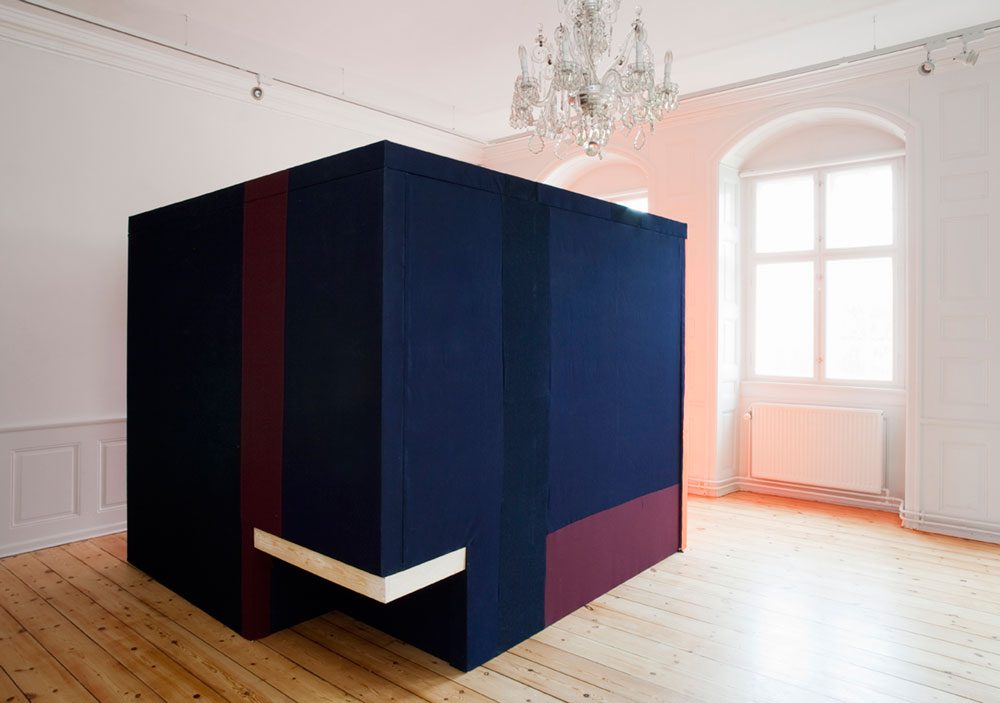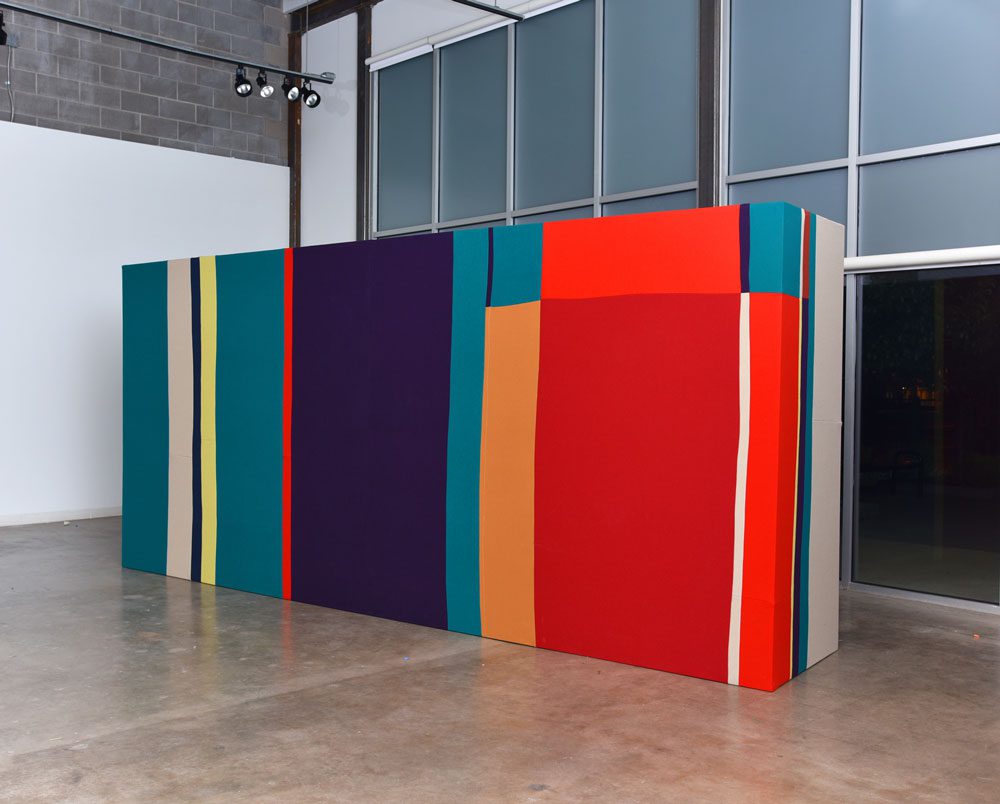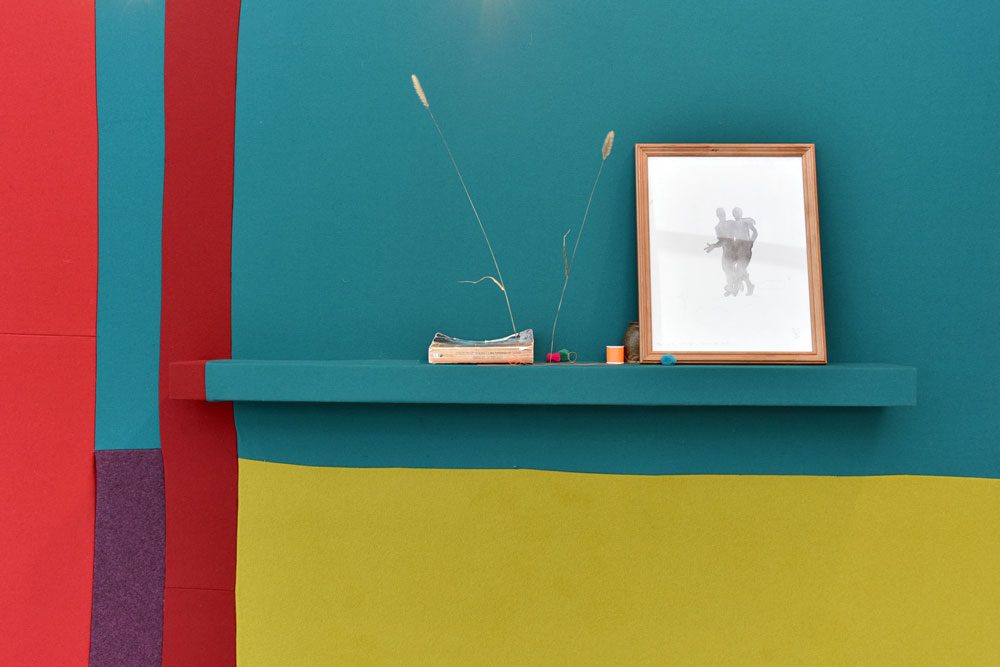Many Homes: An Interview with Rashawn Griffin
Amy Mackie talks to Rashawn Griffin about his residency last year at the Joan Mitchell Center in New Orleans and his participation in “Open Spaces,” which opens next month at venues across Kansas City.

Installation view of Rashawn Griffin’s Untitled (sunrise), 2014, at the Rønnebæksholm, Næstved, Denmark. Courtesy the artist.
Editor's Note
Rashawn Griffin is an artist who allows his ideas and interests to guide where he lives, which is constantly shifting. Likewise, he works with a variety of materials including wood, textiles, and food to build paintings, sculptures, and installations inspired by the architecture of these disparate landscapes and cityscapes. His work is often difficult to describe, but it seems to reveal traces of the various communities through which he travels. Griffin was a resident at the Joan Mitchell Center (JMC) in New Orleans in April 2017.
One of Griffin’s notable room-sized installations, Untitled (sunrise), 2014, was included in the exhibition “Minimal Baroque” at the Rønnebæksholm in Næstved, Denmark. The work is a massive wooden cube covered with tightly stretched fabric that must be installed near a window, allowing natural light to shine in. The deep blue denim and burgundy colors on one side are subdued, though the seams and rough edges of the fabric lend definition and boundaries to the sculpture. On the other side, an entrance is framed by vivid orange hunting fabric. Lined with silver reflective material, the interior glows with warm sunlight. Griffin’s work will be included in “Open Spaces,” curated by Dan Cameron in Kansas City, opening in August 2018. For this citywide exhibition in Griffin’s hometown, the artist is creating a similar installation that allows visitors to encounter an immersive, architectural space within the gallery.
To reflect on his residency at the JMC, I spoke with Griffin last October via Skype.
—Amy Mackie
Amy Mackie: We’ve known each other for nearly two decades, and it’s been so nice to reconnect with you in New Orleans. It has been interesting to witness this city through your eyes. What are your impressions of New Orleans? As a place? As a community?
Rashawn Griffin: I initially came down for a long weekend and quickly realized that New Orleans is an amazing city. At the recommendation of you and artist Anthony Baab, I applied for a residency at the JMC because I really wanted to get more acquainted with this city. I’m the kind of person who forms relationships with cities and communities, so it was important for me to experience New Orleans for a longer period of time.
AM: Do you find that New Orleans differs from other Southern cities where you’ve spent time?
RG: Well, I grew up in Kansas City, which is considered the Midwest though there are parts that might have Southern aspects, but New Orleans is different. Even different than Florida or other parts of the South. It definitely feels like a northern Caribbean city, as I’ve heard people say. [That identity] informs the way one navigates the city, the way people speak to each other, the look of the architecture. My experience of a place is often what inspires my work, how it makes me feel, its tactile qualities.
AM: Were you particularly drawn to the architecture here?
RG: It’s beautiful. I was also intrigued by the [architectural] transitions from spaces to spaces. Rooms within rooms, or outside spaces within inside spaces, the spaces in between. It becomes a unique experience to figure out how to navigate the city. I also experienced weather differently there. It’s as though the water comes from the ground as much as it does from the sky.

Installation view of Rashawn Griffin’s Home and a Stranger, 2016, at RedLine Center for Contemporary Art, Denver. Courtesy the artist.
AM: How do you choose your materials? Or do they find you?
RG: I think, with my work, place plays a really big role—or even the idea of a place and that filters down structurally and physically to the materials I use. Early on, my practice was more clearly about making a connection between how I was living and the things I was making. The “recycled” materials I used then were literally just the things in my possession. Everything I had was going into my work, both my energy and my belongings.
AM: Was that out of necessity, using what you had?
RG: Somewhat, but I also was just coming out of a place of painting into the realm of physical objects and I wanted to understand the materials I was using to make work differently. It became a negotiation between public and private, things that meant something to me, on display, and what that might mean—the food I was eating and the clothes I was wearing. Those early bed pieces I made were just constructed of things I already had.
Clifford [Owens] and I used to talk about how although his work is performance and photography, he used sculpture as a point of contention. Whereas my work is object-based, but the performative aspect plays a big role and is a reflection of my lifestyle. The exhibition “Work Ethic,” curated by Helen Molesworth at the Baltimore Museum of Art, was a huge influence on my work when I was a student at the Maryland Institute College of Art.
AM: I also spent a lot of time with that exhibition. It is one of my favorite shows ever.
RG: The idea of making and working and doing was very strong in that exhibition. The performative aspect of making was a big influence on how I conceive of sculpture and objects in space and also the use of documentation and the way things were arranged. As my practice grew or maybe as I ran out of things, I began to think differently about “stuff.” I started thinking things such as: What does it mean to put your pants on the wall? Can I transform the meaning of an object by placing it in a public place? As my practice grew, I guess I got more into shopping (laughs) buying things and finding things that way, not really salvaging, but discovering. My mom is a bit of a collector, so I guess that is her influence on me. I feel like I’m always looking for “things.”
AM: What does your mom collect?
RG: My parents were really big fans of Star Trek: The Next Generation and we used to watch it together as a family, so my mom began collecting Star Trek figures and toys that now line the walls of their house. All of them are still in their original packaging. She also has a collection of elephant objects and things. It’s kind of amazing, but also ridiculous. She is definitely a collector. I’m not a collector in that way. I collect ideas and materials, material ideas. I guess my palate has expanded over time, which allows me to pick and choose more freely. The materials and textures of a city also inform my work.

Installation view of Rashawn Griffin’s Home and a Stranger, 2016, at RedLine Center for Contemporary Art, Denver. Courtesy the artist.
AM: I find it interesting that you have referred several times to place and to collecting. You are someone who seems to embrace placelessness, or rather you are someone with many homes, but you also like to collect things, though you don’t necessarily have one place to accumulate them.
In Alice Thorson’s Art in America review of your 2012 solo exhibition “A hole-in-the-wall country” at the Nerman Museum of Contemporary Art in Overland Park, Kansas, she states, “The theme of finding himself a place ran throughout this exhibition in works that repeatedly allude to shelter and home.” Do you agree with this assessment? Is this true of your current work?
RG: I think so. I had a really good dialogue with Alice and I felt that she understood what I was trying to express. Art-making doesn’t necessarily come from a place of language, so it seems like it might be difficult to apply words to my process. The biggest piece in that show was actually a 20-foot banner with my name, “Griffin” and a comma, then “KS.” “Griffin, KS.” As if it were a pennant for a town called Griffin, Kansas. The other interesting thing about that show is that it took place about ten minutes from where I grew up. Childhood friends, family, everyone was there, it was like a weird homecoming. Prior to the opening of the exhibition, I had been spending a lot of time in Kansas City, probably the most time since I was young, so it oddly became the place that I was rooted in at that moment since I could easily come and go from there. I actually feel like there is a sense of dislocation that happens in the affect of my work, like the idea of being in place, but not being there at the same time is somehow relevant. The pennant became the starting point for generating work about that place and for that exhibition.
AM: How did your friends and family respond to the pennant?
RG: (laughs) So, I was over at my friend Danny’s house and he has a pennant that says “Volin, SD.” [Danny’s last name is Volin.] I thought it was a really nice pennant and I asked him where he got it. He told me that there is a town in South Dakota called Volin. I said that I wanted one of those and he said, “You can’t have one because your relatives didn’t found a town in South Dakota called Volin.” And I thought, well, I’m an artist, I can make things. So, I made a replica of the Volin pennant, only I made it 20 feet tall and I put my own name on it. I think Danny simultaneously loves and hates the piece.
AM: In the context of your work and the exhibition, that was very much a homecoming, intentional or not, and it makes a lot of sense as an entry point.
RG: Kansas City is always a place where I can get away from things, but also connect to things. I keep a studio there. And also, a lot of my work has gotten bigger, like 30 feet tall, and they need to be assembled, so working in KC, I can work on a larger scale than I can in New York or other places. I can conceive of something in Kansas and then pack up fabric and other materials and assemble them for an exhibition in another city.

Installation view of Rashawn Griffin’s Griffin, KS, 2012, at the Nerman Museum of Contemporary Art, Overland Park, Kansas. Courtesy the artist and the Nerman Museum of Contemporary Art, Overland Park, Kansas
AM: After your residency at the Joan Mitchell Center, you also had a residency at Atlantic Center for the Arts in New Smyrna Beach, Florida. Can you tell me about that residency?
RG: They have a Master Artist Residency program. They invite three Master Artists, myself included, from various fields—visual arts, performing arts, theater, music, writers, architects, etc. The residency is unique in that it is a mentoring program that couples Master Artists with selected Associate Artists for three-week periods. The idea is that this will create a cross-pollination between the artists and their work. It’s really up to the artists to decide how things are run. I worked with a lot of people whose practices overlapped with mine and in different ways. I didn’t think of it as a school or a critique kind of situation, but more about relationship-developing. It was an amazing experience.
AM: Were you and the other artists expected to complete new work as a result of this residency?
RG: It was more about process and dialogue, not about a finished product.
AM: Have you taught elsewhere?
RG: I’ve taught off and on since 2008 or so. I had a fellowship at the University of South Florida where I worked with undergraduate and graduate students and I also worked with senior thesis students at the Maryland Institute College of Art for two years, and before that I did short stints at the Cooper Union and the Kansas City Art Institute. I love engaging with students and young artists, but don’t do it all the time.
AM: What are your intentions when you make work? How do you talk about it with your students?
RG: I’ve always been interested in a kind of self-portraiture and an exploration of the self, and [my work has] always been about asking questions and walking the line between the personal and the public. Even working in the realm of abstraction, there’s always going to be a degree of hermeticism in taking something from one context and moving it to another. There’s a level of removal. And then another. And another. You have to engage with the work on its own level, with language the object understands. I think it’s really all about finding one’s own agency within larger systems. In Michel de Certeau’s [essay] “Making Do: Uses and Tactics,” in The Practice of Everyday Life, he talks about how one navigates the city by walking through the city, one takes the path that inspires them, even if it’s not necessarily the most efficient way of getting from point A to point B, but it’s the agency that inspires the journey on the path.
AM: Do you feel that intuition is an important part of your practice? How much planning do you do before you begin a new work? Do you make a lot of preparatory drawings?
RG: Well, I make a lot of drawings, but they happen after I’ve made an object. I sometimes show them with my sculptures, but sometimes not.
AM: That’s interesting.
RG: Sometimes they interact with my sculptures and bigger pieces in space. I like the intimate moments, the one-on-one moments, within the big picture. I heard a really great talk recently at the Kemper Museum [of Contemporary Art in Kansas City] by the abstract artist Lilian Thomas Burwell. She spoke about the creative process and was talking about the creative act as being part of being human—it’s part of everyone. It was a very inspiring talk.
AM: Do you have any residencies lined up in the coming year?
RG: No, but I spend a lot of time in other places, just not in an official capacity.
AM: Where is the place you’re most interested in spending time?
RG: Well, I think of my work as experiential. I try to value the place I’m in at any given moment. I feel like I think about returning to places I’ve been, rather than thinking about going to new places. I like to visit the relationships I’ve formed with cities and New Orleans is one of those places.
Editor's Note
“Open Spaces” is on view August 25–October 28, 2018, at various locations across Kansas City, Missouri.



